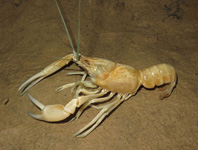Abstract
Cherax acherontis n. sp., is a crayfish endemic to the submerged river Yumugima in Hagepma/Jugurama cave in the New Guinea Highlands, Jayawijaya Regency, Papua Province, Indonesia. This species is the first cave crayfish from the Southern Hemisphere. The new species is most similar to Cherax monticola. Both species can be easily distinguished by certain morphological characteristics, which easily demonstrate C. acherontis n. sp. is a valid species.
References
Bláha, M., Patoka, J., Kozák, P. & Kouba, A. (2016) Unrevealed diversity in New Guinean crayfish species: The evidence from molecular data. Integrative Zoology, 11, 457–468.
https://doi.org/10.1111/1749-4877.12211Crandall, K.A. & De Grave, S. (2017) An updated classification of the freshwater crayfishes (Decapoda: Astacidea) of the world, with a complete species list. Journal of Crustacean Biology, 37, 615–653
https://doi.org/10.1093/jcbiol/rux070Hobbs, H.H. Jr. & Barr, T.C. (1960) The origins and affinities of the troglobitic crayfishes of North America (Decapoda, Astacidae). I. The genus Cambarus. The American Midland Naturalist, 64, 12–33.
https://doi.org/10.2307/2422890Hobbs, H.H. Jr, Hobbs, H.H. III. & Daniel, M.A. (1977) A review of the troglobitic decapod crustaceans of the Americas. Smithsonian Institution Press, City of Washington, pp. 183.
https://doi.org/10.5479/si.00810282.244Holthuis, L.B. (1950) Results of the Archbold expeditions. No 63 The Crustacea Decapoda Macrura collected by the Archbold New Guinea expeditions. American Museum Novitates, 1461, 1–17.
Lukhaup, C. (2015) Cherax (Astaconephrops) pulcher, a new species of freshwater crayfish (Crustacea, Decapoda, Parastacidae) from the Kepala Burung (Vogelkop) Peninsula, Irian Jaya (West Papua), Indonesia. ZooKeys, 502, 1–10.
https://doi.org/10.3897/zookeys.502.9800Lukhaup, C., Eprilurahman, R. & Von Rintelen, T. (2017) Cherax warsamsonicus, a new species of crayfish from the Kepala Burung (Vogelkop) peninsula in West Papua, Indonesia (Crustacea, Decapoda, Parastacidae). ZooKeys, 660, 151–167.
https://doi.org/10.3897/zookeys.660.11847Munasinghe, D., Burridge, C. & Austin, C. (2004) Molecular phylogeny and zoogeography of the freshwater crayfish genus Cherax Erichson (Decapoda: Parastacidae) in Australia. Biological Journal of the Linnean Society, 81, 553–563.
https://doi.org/10.1111/j.1095-8312.2003.00299.xPatoka, J., Bláha, M. & Kouba, A. (2015a) Cherax (Astaconephrops) gherardii, a new crayfish (Decapoda: Parastacidae) from West Papua, Indonesia. Zootaxa, 3964, 526–536.
https://doi.org/10.11646/zootaxa.3964.5.2Patoka, J., Bláha, M. & Kouba, A. (2015b) Cherax (Cherax) subterigneus, a new crayfish (Decapoda: Parastacidae) from West Papua, Indonesia. Journal of Crustacean Biology, 35, 830–838.
https://doi.org/10.1163/1937240X-00002377Stern, D.B., Breinholt, J., Pedraza, C., López-Mejía, M., Owen, C.L., Bracken-Grissom, H., Fetzner, J.W. & Crandall, K.A. (2017) Phylogenetic evidence from freshwater crayfishes that cave adaptation is not an evolutionary dead-end. Evolution, pp. 2522–2532.
https://doi.org/10.1111/evo.13326

